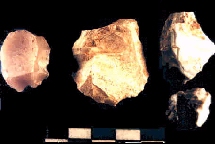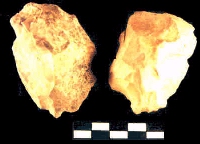
Figure 13: Sima de las Palomas: distribution of raw materials of artifacts (retouched and unretouched flakes, spalls and fragments) right, unstratified; left, stratified.
Sima de las Palomas Mousterian artifacts (Table 33 - pdf only) differ curiously from those at Cueva Negra. Here, unstratified finds outstrip those systematically excavated as yet. Comparison, in terms of rock type of stratified and unstratified pieces (Figure 13), indicates disproportionate representation, with respect to quartz pieces, of both dolomite/limestone and chert/flint in the unstratified collection in contrast to the excavated one.

Figure 13: Sima de las Palomas: distribution of raw materials of artifacts (retouched and unretouched flakes, spalls and fragments) right, unstratified; left, stratified.
This perhaps reflects spatiotemporal differences at Sima de las Palomas as yet undisclosed by our systematic excavation of only a minute part. Still, chert/flint predominates in our collection, followed by quartz and hard limestone/dolomite in similar proportions (Figure 14).

Figure 14: Sima de las Palomas: distribution of raw materials of artifacts in the entire collection to date.
Figures 13-14 could imply that whilst locally available limestone was knapped at or beside the site as need arose, more care was taken of chert/flint that was carried uphill from further afield, and perhaps subject to more resharpening or reuse. The area of an erstwhile rock-shelter over the present shaft was <20m², and the steepness of the hillside precludes any terrace outside, so the site is hardly appropriate for a knapping workshop. More plausibly, it was a look-out over the plain below - doubly convenient had there bubbled up a spring of fresh water nearby.

Figure 15: Sima de las Palomas: distribution of artifacts by type.
Among clear-cut artifact types, unretouched flakes predominate (Figure 15), followed by flat side-scrapers, and then end-scrapers, after which denticulates, points, and hammer-stones, comprise equal proportions. (A few blades from unstratified rubble could have been dropped on the hillside in upper palaeolithic times.) Unretouched flakes are mainly limestone/dolomite (Figure 16), followed by chert/flint, and quartz (notwithstanding our discard of dolomite/limestone flakes lacking adherent breccia, when coarse-sieving mine rubble).

Figure 16: Sima de las Palomas: rock types of all struck flakes (unretouched and retouched)
Distribution of rock types, with predominance of chert/flint, is broadly-speaking similar both for flattish side-scrapers (Figure 17) and thick, steep, or end-scrapers (Figure 18) with a retouch angle >40º/50º, whereas more denticulate/notched pieces are of quartz than chert/flint or quartzite.

Figure 17: Sima de las Palomas: rock types of falttish side-scrapers

Figure 18: Sima de las Palomas:rock types of thick, steep or end scrapers
Overinterpreting these differences is unwise, because the collection is still overwhelmingly of unstratified finds. If systematically excavated finds alone were considered, there'd be far too few for meaningful quantitative inferences to be drawn at all.
It's more fruitful to consider qualitative aspects. Levallois and pseudo-Levallois points (flat, unretouched) stand out in the collection, whether on chert/flint or dolomite/limestone (Plate 35; Figure 19), though we heed warnings both about pitfalls in classifying these points by Boëda, (1994), and practical difficulties over identifying these pieces consistently (Perpère, 1994).

Figure 19: Sima de las Palomas: rock types of both 'stubby' "Mousterian points" (excluding Tayac 'points' and flat Levallois or pseudo-Levallois points

Plate 35: Sima de las Palomas: Levallois and pseudo-Levallois points. Scale in cm. (Photo M.J.Walker)
Also prominent are typically Mousterian "stubby points" which, being thick and heavily retouched, are perhaps best regarded as convergent scrapers; some are on chert/flint, others on quartz/rock crystal - rock crystal was used even for well-made end-scrapers and Tayac "points", some of which are also on chert/flint (such "points" are classified by us as denticulates, following Debénath and Dibble 1994). A wide range of flat side scrapers (Plate 36) is made on chert/flint and most can readily be characterized using geometrical terms such as lateral/transverse/oblique and straight/convex/concave/convergent, though some are hard to classify if they also have features of denticulates or gravers (burins), or are retouched on the striking platform. Two extraordinary identical pieces deserve mention (Plate 37), one of flint, the other limestone, recall thick, oval, Levallois flakes; further scrutiny shows each bears a tiny, low, awl-like, "nose" flanked by two notches and itself strengthened by diminutive, steep, flake scars: maybe these were awls or borers for piercing skins. Skins can be degreased and made supple by using ochre during scraping, and ochre has been found at both our sites (whether it was also used for body-painting remains in the realm of fancy).

Plate 36: Sima de las Palomas: flat side scrapers. Scale in cm. (Photo M. J. Walker)

Plate 37: possible borers or awls on flakes. Scale in cm. (Photo M. J. Walker)
© Internet Archaeology
URL: http://intarch.ac.uk/journal/issue5/walker/4.6.html
Last updated: Wed Dec 23 1998